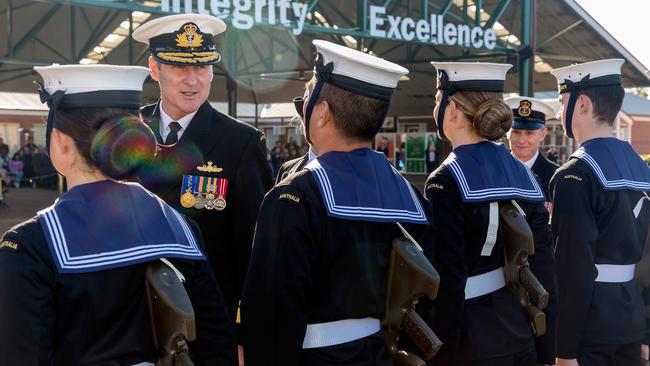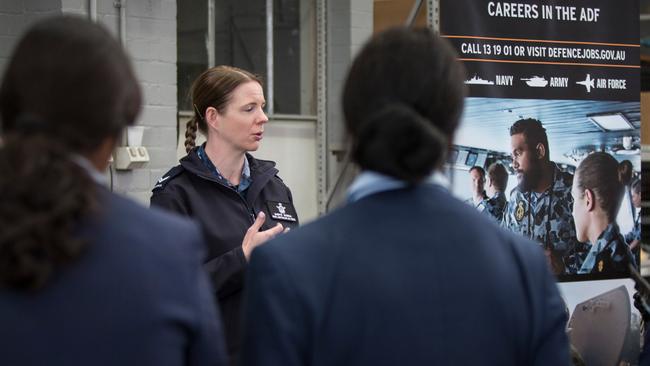ADF to reduce time it takes recruits to join from around 300 days to 100
The Australian Defence Force is set to take a drastic measure to urgently get more people in the ranks. See how it will work.
National
Don't miss out on the headlines from National. Followed categories will be added to My News.
Exclusive: The Australian Defence Force will cut at least 200 days from its onerous recruitment program to urgently boost the ranks to fill new national security capabilities being set out by the Defence Strategic Review.
The current recruitment process incredibly averages 300 days for each potential new member processing, up to a year for specialist technical staff.
But those timings will now be cut by two thirds to no more than 100 days and possibly less with more recruiters, tighter security vetting deadlines and targeted programs to streamline the process.
The proposed change comes as the Federal Government will next month receive the highly anticipated Defence Strategic Review (DSR) blueprint for the future of our national security, with recruiting among the priorities.

The national skills shortage and tight labour market is already posing a challenge for Defence but now it needs specialists notably for electronic warfare, nuclear propulsion and remote sensing let alone general military enlistments.
The ADF’s biggest peacetime push is hoping to recruit more than 80,000 personnel, or an increase of 30 per cent by 2040. Defence forecasts it is currently able to reach 72 per cent of its 2022/23 enlistment target.
Defence Personnel Minister Matt Keogh confirmed ADF recruitment was under “pressure” and needed to grow now to meet the demands to come.

He confirmed plans were already underway to reduce the time it takes to join and the DSR would likely recommend more in both recruitment and retention.
“At the moment that recruitment process averages about 300 days, we are looking to bring that down to about 100 and if we can get it shorter then we will do that as well because we do not want to be losing people who find other opportunities while we are taking them through that recruitment process,” he told News Corp Australia.
“It is a strategic review, obviously an element of that is going to be our most important capability which is our people and so those sorts of things will be relevant I’m sure.”
Mr Keogh would not go into detail but said recruitment/retention would “evolve” to incorporate other incentives in education and health.

It would also address one of the biggest enlistment imposts of family separation, where personnel are deployed to the other side of the country or the world.
“We have the Defence Strategic Review coming to government, no doubt elements that will come from that will have us looking further at what we can do to increase that recruitment but also that retention,” he added.
One element understood to be under consideration by the DSR, due to be handed to the government in the first week of February, is greater partnering between civilian industry and military and part-time reservist expertise in a broader timeshare arrangement.
This includes the principle of “just-in-time” training, a targeted needs-related basis to skills training with shorter structured enlistment.
COMMENT
In 1915, the then Defence Department launched its infamous “Call from the Dardanelles” campaign.
Posters festooning train stations, town halls and community gatherings featured an Australian Digger with slouch hat on his head, a Lee Enfield on his shoulder and hands cusped to his mouth and the caption “Coo-ee Won’t you come?”.
It was a crude nationalistic recruitment pitch to Australians for the British Empire but it saw enlistments surge and is the kind of patriotic symbolism we need again.
Okay maybe a little more sophisticated and digital but it was a success for the simple reason it was an appeal by the nation for the nation.
The ADF needs to boost its ranks now not just because Australia faces its greatest geostrategic challenge since the era of the great world wars but come a crisis there is no way it can just flick a switch and have enough personnel to man its defences.

It already struggles to staff hardware such as ships to sea, aircraft in the air let alone when newer higher tech fighting tools like drones, cyber offensives, AI and Quantum program weapon systems or even nuclear-propelled submarines come on line.
It is a contribution to our national interest and national security but also provides a sense of purpose in communities looking to combat local climate related emergencies whether floods and fires locally or disasters and rising sea levels in the Pacific.
Reducing the recruitment time from up to a year makes sense but a whole lot more needs to be done to attract and retain personnel in an already challenged labour market. The ADF cannot compete with private sector salaries but incentives in tax breaks, health and education benefits, generous superannuation and more home trips for deployed troops can make it more appealing.
Incentives for the re-employment of skilled veterans in a part time roles should also be looked at more closely as well as industry job share schemes.
The ADF has missed its cumulative recruitment targets every year since the Coalition came to power in 2013, under the current government Defence will be forced to think outside the square and come up with a new cooee call.
More Coverage
Originally published as ADF to reduce time it takes recruits to join from around 300 days to 100




